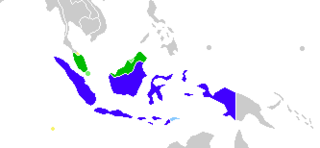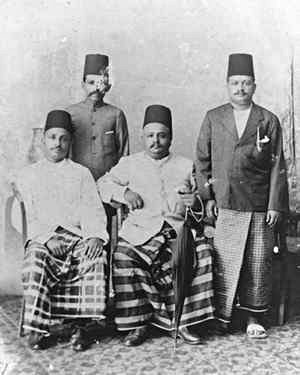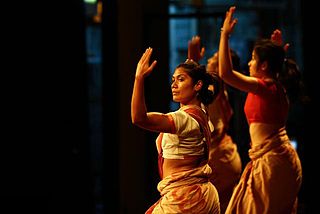Related Research Articles

The demographics of Malaysia are represented by the multiple ethnic groups that exist in the country. The official estimate of 2024 Malaysia's population is about 34,100,000 people. According to the 2020 census, is 32,447,385 including non-citizens, which makes it the 43rd most populated country in the world. Of these, 5.72 million live in East Malaysia and 22.5 million live in Peninsular Malaysia. The population distribution is uneven, with some 79% of its citizens concentrated in Peninsular Malaysia, which has an area of 131,598 square kilometres (50,810.27 sq mi), constituting under 40% of the total area of Malaysia.

Malay is an Austronesian language that is an official language of Brunei, Indonesia, Malaysia, and Singapore, and that is also spoken in East Timor and parts of Thailand. Altogether, it is spoken by 290 million people across Maritime Southeast Asia.
Manglish is an informal form of Malaysian English with features of an English-based creole principally used in Malaysia. It is heavily influenced by the main languages of the country, Malay, Tamil, and varieties of Chinese. It is not one of the official languages spoken in Malaysia.

Terengganu is a sultanate and federal state of Malaysia. The state is also known by its Arabic honorific, Dāru l-Īmān. The coastal city of Kuala Terengganu, at the mouth of the Terengganu River, is both the state and royal capital as well as the most populous city in Terengganu. Other major cities and towns include Jerteh, Kuala Dungun, Chukai, Kuala Berang, Marang, and Permaisuri. At 13,035 square kilometres in size and a population of over 1.2 million people in 2023, Terengganu is Malaysia's 7th largest state and 10th most populated. Terengganu, along with Kelantan, Perlis, and the Federal Territory of Putrajaya, is one of the most homogeneous states/territories in the country of which 95% of the population are ethnic Malay-Muslims with its own distinct language/dialect, culture, history, and tradition.

Bangsar is a residential suburb on the outskirts of Kuala Lumpur, lying about 4 kilometres (2.5 mi) south-west of the city centre. It is part of the Lembah Pantai parliamentary constituency. Bangsar is administered by Dewan Bandaraya Kuala Lumpur (DBKL), unlike other townships in the Klang Valley such as Petaling Jaya and Subang Jaya which have their municipal councils. Neighbourhood residents' associations and business councils play a part in communicating with the local authority, but they exercise no legal or administrative power. Malays make up most of the population at 61%, followed by the Chinese at 24%, Indians at 15%.

Islam in Malaysia is represented by the Shafi‘i school of Sunni jurisprudence. Islam was introduced to Malaysia by traders arriving from Persia, Arabia, China and the Indian subcontinent. It became firmly established in the 15th century. In the Constitution of Malaysia, Islam is granted the status of "religion of the Federation" to symbolize its importance to Malaysian society, while defining Malaysia constitutionally as a secular state. Therefore, other religions can be practiced legally, though freedom of religion is still limited in Malaysia.

The Culture of Malaysia draws on the varied cultures of the different people of Malaysia. The first people to live in the area were indigenous tribes that still remain; they were followed by the Malays, who moved there from mainland Asia in ancient times. Chinese and Indian cultural influences made their mark when trade began with those countries, and increased with immigration to Malaysia. Other cultures that heavily influenced that of Malaysia include Persian, Arabic and British. The many different ethnicities that currently exist in Malaysia have their own unique and distinctive cultural identities, with some crossover.
Keling or Kling is an exonym to denote a Tamilian or someone deemed to have originated from South India. Originally a neutral term, since the mid-20th century it has been considered derogatory and an ethnic slur, and it is sometimes euphemistically referred to as the K-word. The term is used in parts of Southeast Asia, particularly the Malay Archipelago where there are a significant Tamil diaspora – specifically Malaysia, Indonesia, Singapore and Brunei – but cognates exist in neighbouring countries as well.

Sup kambing or sop kambing is a Southeast Asian mutton soup, commonly found in Brunei Darussalam, Indonesia, Malaysia, Singapore. It is prepared with goat meat, tomato, celery, spring onion, ginger, candlenut and lime leaf, its broth is yellowish in colour. Sup kambing is quite widespread as numbers of similar goat meat soup recipes can be found throughout Malaysia, Indonesia and Singapore.

Sri Lankan Moors are an ethnic minority group in Sri Lanka, comprising 9.3% of the country's total population. Most of them are native speakers of the Tamil language. The majority of Moors who are not native to the North and East also speak Sinhalese as a second language. They are predominantly followers of Islam. The Sri Lankan Muslim community is mostly divided between Sri Lankan Moors, Indian Moors, Sri Lankan Malays and Sri Lankan Bohras. These groups are differentiated by lineage, language, history, culture and traditions.
The 1989 Taufiqiah Al-Khairiah madrasa fire, which occurred on 22 September 1989, was a fire that took place at Taufiqiah Al-Khairiah madrasa in Guar Chempedak, Kedah, Malaysia. Around 27 students, mostly girls, were killed in the incident. All bodies of the victimes were later buried in a special Muslim cemetery at Padang Lumat, they were named as the "27 Syuhada Peristiwa Kebakaran Pondok Pak Ya".
The Jawi Peranakan is an ethnic group found primarily within the Malaysian state of Penang and in Singapore, both regions were part of the historical Straits Settlements where their culture and history is centred around. The term "Jawi Peranakan" refers to locally born, Malay-speaking Muslims of mixed Indian and Malay ancestry. Over time, this has grown to include people with Arab ancestry as well. They were an elite group within the British Malayan community in mid-19th century Malaya. In addition to their substantial wealth and social standing, they are remembered for setting up the first Malay newspaper in Malaysia, Singapore, Indonesia and China, the Jawi Peranakan and their influences on Malay culture.

Islam is the state religion of Malaysia, as per Article 3 of the Constitution. Meanwhile, other religions can be practised by non-Malay citizens of the country. In addition, per Article 160, one must be Muslim to be considered Malay. As of the 2020 Population and Housing Census, 63.5 percent of the population practices Islam; 18.7 percent Buddhism; 9.1 percent Christianity; 6.1 percent Hinduism; and 2.7 percent other religion or gave no information. The remainder is accounted for by other faiths, including Animism, Folk religion, Sikhism, Baháʼí Faith and other belief systems. The states of Sarawak and Penang and the federal territory of Kuala Lumpur have non-Muslim majorities. Numbers of self-described atheists in Malaysia are few as renouncing Islam is prohibited for Muslims in Malaysia. As such, the actual number of atheists or converts in the country is hard to ascertain out of fear from being ostracised or prosecution. The state has come under criticism from human rights organisations for the government's discrimination against atheists, with some cabinet members saying that "the freedom of religion is not the freedom from religion".

Mee goreng, or mi goreng, refers to fried noodles in the Malay-speaking cultures of several countries, such as the Southeast Asian states of Brunei, Malaysia, and Singapore.

The Hadharem or the Hadhrami are an Arabic-speaking ethnographic group indigenous to the Hadhramaut region in South Arabia, which is part of modern-day Yemen. The spoken language of the Hadharem within Hadhramaut is Hadhrami Arabic. Among the two million inhabitants of Hadhramaut, there are about 1,300 distinct tribes.

Malaysian Indians or Indo-Malaysians are Malaysian citizens of Indian or South Asian ancestry. Most are descendants of those who migrated from India to British Malaya from the mid-19th to the mid-20th centuries. Most Malaysian Indians are ethnic Tamils; smaller groups include the Malayalees, Telugus and Punjabis. Malaysian Indians form the fifth-largest community of Overseas Indians in the world. In Malaysia, they represent the third-largest group, constituting 7% of the Malaysian population, after the Bumiputera and the Chinese. They are usually referred to simply as "Indians" in English, Orang India in Malay, "Yin du ren" in Chinese.

Malaysian Indian cuisine, or the cooking of the ethnic Indian communities in Malaysia, consists of adaptations of authentic dishes from India, as well as original creations inspired by the diverse food culture of Malaysia. Because the vast majority of Malaysia's Indian community are of South Indian descent, and are mostly ethnic Tamils who are descendants of immigrants from a historical region which consists of the modern Indian state of Tamil Nadu and Sri Lanka's Northern Province, much of Malaysian Indian cuisine is predominantly South Indian inspired in character and taste. A typical Malaysian Indian dish is likely to be redolent with curry leaves, whole and powdered spice, and contains fresh coconut in various forms. Ghee is still widely used for cooking, although vegetable oils and refined palm oils are now commonplace in home kitchens. Before a meal it is customary to wash hands as cutlery is often not used while eating, with the exception of a serving spoon for each respective dish.

Penangite Indians, also known as Chulias, are Malaysian Indians that live primarily in the state of Penang, Malaysia. Most are the descendants from those who migrated from India during the British colonisation of Malaya. However, historical sources prove that the ancient Indians arrived in Penang during the Chola dynasty. Penangite Indians forms a large percentage of the state's professional community such as business, law and medicine as well as politics, it can be proven by the appointment of Dr. P. Ramasamy as deputy chief minister of Penang. It made him the first Malaysian of Indian origin to hold the post of deputy chief minister in any state of Malaysia. In addition, first Tamil Vernacular School in Malaysia was established in Penang.

Mamak stalls are indoor and open-air food establishments particularly found in Southeast Asia, especially in Malaysia and Singapore, where the cuisines served are typically those derived from Indian Muslim and Pakistani cuisines, unique to the region.

Malaysian Malayalees, also known as Malayalee Malaysians, are people of Malayali descent who were born in or immigrated to Malaysia from the Malayalam speaking regions of Kerala. They are the second largest Indian ethnic group, making up approximately 15% of the Malaysian Indian population. The bulk of Malaysian Malayali migration began during the British Raj, when the British facilitated the migration of Indian workers to work in plantations, but unlike the majority Tamils, the vast majority of the Malayalis were recruited as supervisors in the oil palm estates that followed the kangani system, and some were into trading and small businesses with a significant proportion of them running groceries or restaurants. Over 90% of the Malayalee population in Malaysia are Malaysian citizens.
References
- 1 2 Hassan Mydin, Shaik Abdullah; Saidumasudu, Mohammed Siraaj (2018). "The Changing Identities of the Tamil Muslims from the Coromandel Coast to Malaysia: An Etymological Analysis". Proceedings of the 7th International Conference on Multidisciplinary Research. SCITEPRESS - Science and Technology Publications. pp. 650–656. doi: 10.5220/0008891906500656 . ISBN 978-989-758-437-4.
- ↑ Abdullah., Chuah, Osman (2011). Indian Muslims in Malaysia : a Sociological Analysis of a Minority Ethnic Group. OCLC 778289344.
{{cite book}}: CS1 maint: multiple names: authors list (link) - 1 2 "As A Mamak Living In Malaysia, Here's What I Wish People Knew About Us - In Real Life". 2020-08-18. Retrieved 2022-03-29.
- ↑ A., Bakar Hamid (n.d.). Peristiwa-peristiwa dari Hikayat Hang Tuah, diselenggarakan oleh A. Bakar Hamid. [publisher not identified]. OCLC 844921183.